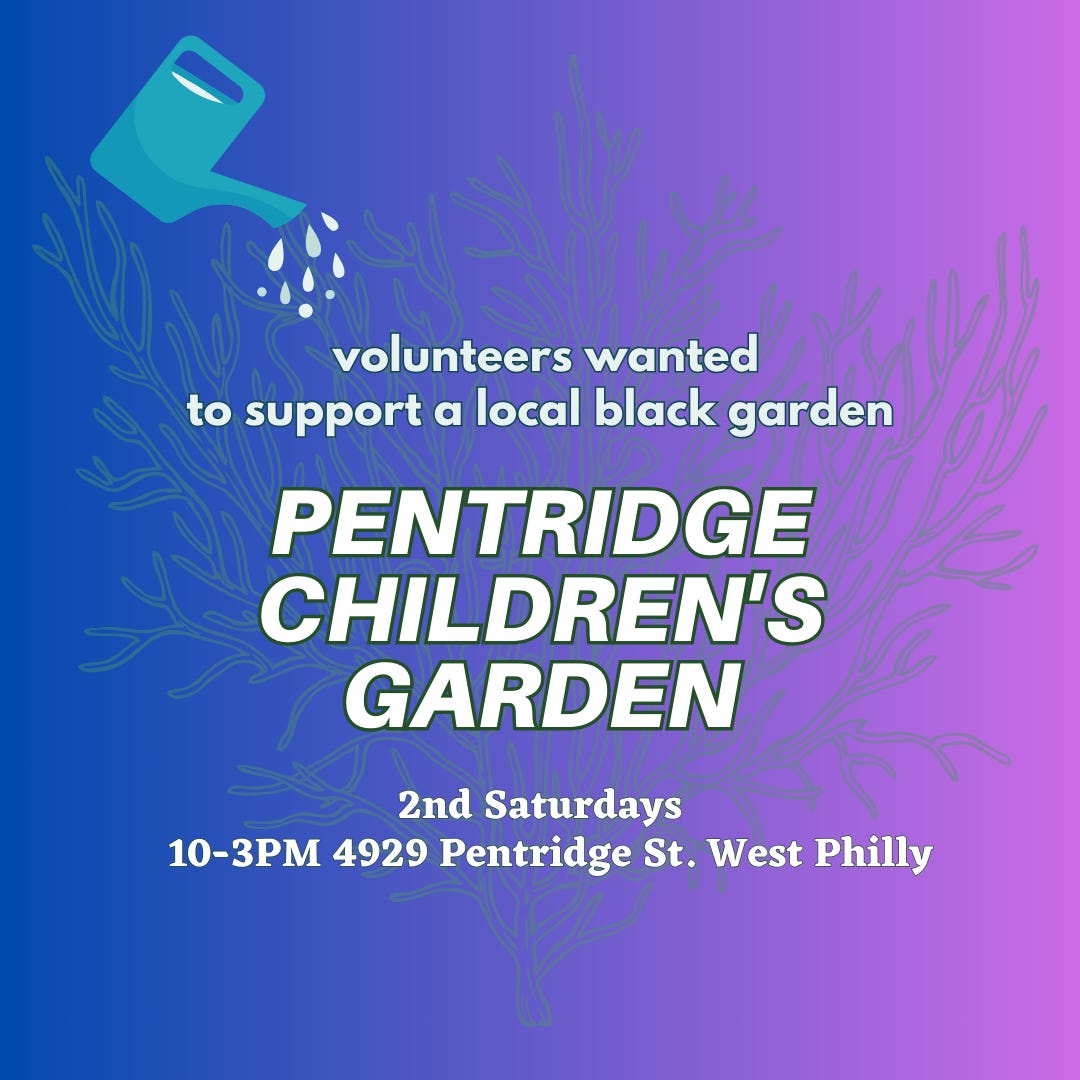
Before diving into the essay on joy and play from our very own communications specialist, French, an announcement: The frost of winter has finally dissolved here in West Philly. Blossoms sprout from the trees and daffodils pepper the sidewalk. With the arrival of warmer weather comes Pentridge Children’s Gardens Spring Kickoff of 2nd Saturday Work Days on April 12, 2025 from 10am to 3pm. Volunteer and support our local Black garden in constructing garden beds, and other work towards preparing the garden for growing this season. We hope to see you there!
Right. Right. Left. Left. Cross, back, right.
I’m talking to my feet as I rewind the YouTube tutorial for the twentieth time. My studio apartment has become a tiny dance studio, and today, I am determined to finally learn the Tamia line dance.
How did I end up here, you ask? What compelled me to wake up on a Saturday morning, rearrange my entire apartment, and commit to mastering a Black line dance that went viral in 2020 during the COVID lockdown?
The story starts earlier this year. Ras, one of DSM.215’s co-founders, and I attended the Nonprofit Leaders’ Circle Well-Being Retreat at Creative Praxis. It was a long day packed with discussions on how to sustain ourselves while doing the challenging work of leading a nonprofit. One idea that stood out to me was the need to play for at least 30 minutes a day—probably because we actually played that day. We engaged in several games, likely intended to help us connect with other attendees and break up the monotony of lectures. At first, my social anxiety and awkwardness kicked in, but soon, I found myself scrambling and cackling with strangers, trying to keep a cup in the air by tapping it once. For a moment, we weren’t nonprofit leaders at a professional event—we were kids on a playground during recess.
That experience made me think about my childhood, a time I’ve largely forgotten, likely because of how traumatic it was. Growing up, my dad’s moods were like seasons, and I learned to adapt accordingly. When he was dating someone new, he was more lenient, and I had more freedom—I could ride my bike with my dog alongside me by the Delaware River, where my best friend lived at the end of the trail. On hot weekends, we’d have water balloon fights with the cute corner boys. Even when my dad was stricter, I found ways to have fun. When I wasn’t allowed outside, I’d watch music videos on BET and MTV, teaching myself the choreography. I was (and still am) obsessed with dancehall—anything by Sean Paul or Beenie Man. I’d stand in front of the mirror for hours, learning how to wine my waist and tick my hips, laughing at my awkwardness and squealing when I finally got the hang of it. Dancing was how I played when I was alone.
Back in my apartment on that Saturday morning, I realized I couldn’t remember the last time I danced like that. I couldn’t remember the last time I felt true joy or glee. And, undoubtedly, these two things were connected. The more I thought about it, the more I realized I hadn’t felt much of anything lately. Over the years, I’ve learned that my body goes numb during periods of high stress and overwhelm—shutting down rather than sinking into despair while witnessing the ever-disintegrating state of the world.
So, I started rearranging my apartment, pushing everything against the walls and turning on my projector. The Tamia line dance had always been on my list to learn. The footwork is intricate, but it has to look effortless. I looked ridiculous at first, stumbling through the steps, feeling the familiar awkwardness of learning something new. But as I kept going, my seriousness thawed. I found myself laughing—cackling at my missteps.
The best part of playing is laughing. Laughter is a symptom of joy, and joy is liberating.
Of course, I’d be remiss not to acknowledge that not everyone has access to joy. Systemic forces—racism, capitalism, misogyny—intentionally work to keep oppressed people from experiencing it. In her essay Black Joy: Resistance, Resilience, and Reclamation for the National Museum of African American History & Culture, Elaine Nichols writes, “Black Joy is an affirmation and an action that claims control where we can. It is not escapism or a way of avoiding reality.”
When I do something that brings me joy—like line dancing—I am exercising my freedom. Protest is not just about boycotts and marches. Resistance takes many forms, and the pursuit of joy is one of the most radical.
Franceska “French” Rouzard is a writer, software engineer and communications specialist based in West Philadelphia. She has several years of experience as a social media manager and writer in corporate spaces and desires to use the skills she’s developed in service to non-profits making a positive impact on our communities, like Deep Space Mind 215.



There’s a meme that says “america falling apart, meanwhile Black people learnin’ a new line dance w/a fan.” 🪭💫 thank you for this lovely reminder to play!